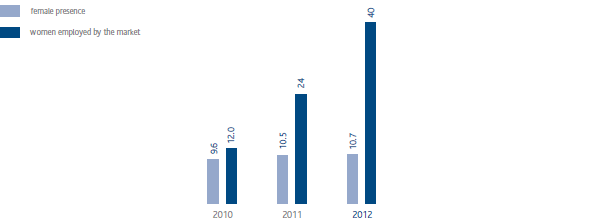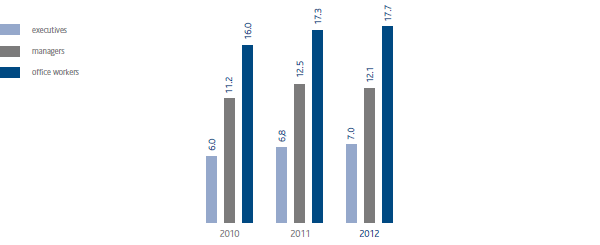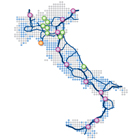
In 2012, action was begun to achieve the initiative aimed at aligning the Group’s corporate organisational structure with the obligations set out in the EU Directive, with the objective of reinforcing the expertise of the individual operating companies.
Legislative Decree 93 of 1 June 2011 implements the EU Directives of the “Third Energy Package”, the objective of which is to create a network across the continent capable of ensuring the security of gas supplies. Following the publication of this Decree, changes in the macro-structure of the Group, which were projected for and in part completed in the final quarter of 2011, has evolved further, creating a Company focussed on the gas transportation business, which has been operational since 1 January 2012. The Group’s new configuration, as well as delivering a series of centralised services, gave Snam’s management the roles of directing, managing and coordinating its business activities: natural gas transportation, distribution and storage and regasification of liquefied natural gas.
During 2012 initiatives to assist the merger between Snam, Snam Rete Gas, Italgas, Stogit and GNL Italia continued, with the aim of improving the overall efficiency of the system, protecting and developing business knowledge in support of the business strategies.
Employment
At 31 December 2012, the Snam Group employed 6,051 people. The analysis, by contractual category and by companies included within the scope of consolidation, is set out in the tables below:
| Download XLS (16 kB) |
|
Personnel by company (number) |
2010 |
2011 |
2012 |
Change |
|
Snam S.p.A. |
|
|
672 |
672 |
|
Snam Rete Gas S.p.A. |
2,636 |
2,755 |
1,978 |
(777) |
|
GNL Italia S.p.A. |
70 |
74 |
78 |
4 |
|
Italgas S.p.A. |
2,570 |
2,479 |
2,551 |
72 |
|
Napoletanagas S.p.A. |
549 |
526 |
465 |
(61) |
|
Stogit S.p.A. |
279 |
278 |
307 |
29 |
|
|
6,104 |
6,112 |
6,051 |
(61) |
| Download XLS (16 kB) |
|
Personnel by status (number) |
2010 |
2011 |
2012 |
Change |
|
Executives |
116 |
118 |
115 |
(3) |
|
Managers |
508 |
544 |
560 |
16 |
|
Office workers |
3,243 |
3,277 |
3,257 |
(20) |
|
Manual workers |
2,237 |
2,173 |
2,119 |
(54) |
|
|
6,104 |
6,112 |
6,051 |
(61) |
During the course of 2012, the number of personnel in service fell by a total of 61, from 6,112 at 31 December 2011 to 6,051 at 31 December 2012.
The measures to rationalise and render efficient the organisational structure have more than offset the restructuring undertaken: to complete the absorption of the services acquired previously by eni or its subsidiaries; to ensure continual adjustment in the qualitative mix of resources; acquiring new licences in the distribution business.
In particular, the headcount figures recorded during 2012 can be summarised as follows:
- an increase of 47 people due to recruitment from the market (including 27 graduates);
- an increase of 24 people, following the acquisition of the ‘Property Services’ business unit by eniServizi (10 people) and from employment management changes following investments made by the Snam Group or by companies belonging to eni S.p.A.;
- a reduction of 17 people, resulting from employment management changes, in particular following transfers out to companies associated with the Snam Group or belonging to eni S.p.A.;
- a reduction of 105 people following termination of employment (including eight unilateral terminations by the Company);
- a reduction of 10 people following employment changes related to the transfer (19) and acquisition (9) of new distribution licences.
About 100 movements were also recorded between various Group companies, with the objective of making an improved and more efficient use of the resources employed in the Group.
A total of 96% of Snam employees have a permanent employment contract. Some 53% of employees work in northern Italy, 21% in central Italy and 26% in the south and Sicily.
EMPLOYEES BY GEOGRAPHICAL AREA (No)
STATISTICAL DIVERSITY: EMPLOYEES BY AGE BRACKET (No)
Almost 11% of total staff is university graduates and 51.8% have diploma qualifications; the average age of people employed by the Group is 49 and the average length of service is about 23 years.
A total of 10.7% of the workforce and 11.1% of executives are women.
FEMALE PRESENCE (%)
FEMALE PRESENCE BY STATUS (%)
Organisation
The principal organisational changes implemented in 2012 were as follows:
- the activity related to the termination of service contracts with eni or with companies it controls was completed. In particular, after the acquisition in 2011 of the eniAdFin business unit, specialised in accounting and administration, and of eni’s business unit specialised in the management of certain ICT services, the activities of property management and personal services (previously outsourced to eniServizi) were also absorbed in 2012;
- phase 1 of the Finance Project, concerning the internationalisation of the related activities previously managed by eni, was completed in late 2012;
- an active project designed to define and propose an organisational model for the identification, management and monitoring over time of the various business risks (Enterprise Risk Management) was launched in June 2012;
- the updating of the ‘Crisis Management Model’ and, as a result, of the ‘Business Continuity Management Programme’, concerning in particular the subjects of Crisis Management and the principle of adopting preventive measures to ensure continuity of service, has been completed. As part of the activities of the Programme, the Business Continuity Management policy was also issued and the Business Continuity Plans for Group companies have been set. The ‘Crisis Management Model’ was established to mitigate the impact of events that may lead to crisis situations;
- a process for the reorganisation of Italgas operations, which involves the management of site and district processes (planning, monitoring and control) and of operational activities with multiple resources throughout the country terminated in April 2012;
- the ‘Standard Operating Procedures’ project at Italgas, conducted in previous years to analyse activity for the operation and maintenance of the network and equipment and to assess how they have been adapted to the specific characteristics of different localities, was completed;
- starting in June 2012, Italgas launched a major project aimed at studying the impact on organisation and management of a significant corporate transaction, such as the setting-up of a joint venture in the north-east of Italy;
- in accordance with the new regulations on concession regimes in the market for gas distribution activities, the planning activity, aimed at adjusting the Company in line with new localities, continued;
- from the organisational perspective in gas transportation, analyses of work processes aimed at managing gas logistics processes were conducted, in accordance with the requirements imposed by changes in the business and regulatory scenarios. Furthermore, concerning activities in the Operations area, the project for the preparation of the new Dispatching centre, where the structure and technologies used have been entirely renewed, was completed;
- the programme to implement the rationalisation of the maintenance centres, dedicated to the maintenance of the gas transportation network, continued.
Involvement and participation initiatives
Encouraging participation, which includes listening to people’s needs and their requests for improvement, fosters a positive internal climate. There are many channels and instruments through which Snam shares its values, challenges, objectives and projects, increasing the level of employee satisfaction in carrying out their activities.
The Group’s intranet site is not only built as a tool for information but also as a place for sharing and developing knowledge. In 2012 a first update to the Energy section, intended for Personnel Services and now called “Snam For You”, was implemented – a section dedicated entirely to the subject of corporate welfare was completely renewed.

During 2012 news and video-news were used as tools to disseminate crucial topics immediately and to mark significant events, such as the 50 online news items published on the intranet site that focus on subjects related to results, corporate life and sustainability and safety at work, as well as the future objectives of the Group with an eye to Europe. To involve all Group employees, Snam produces and uses several different forms of printed matter: posters, flyers, brochures and a newsletter.
The “Sapernedi+” initiative provides a widespread structure for meeting and disseminating the Company’s values and strategies, but also for sharing issues, problems and solutions for each unit’s organisational realities. This was rolled out between the summer and autumn of 2012 to all organisational units, using a cascading process which reached all Snam personnel and became a significant opportunity to share new scenarios and the upcoming group restructuring, but also to compare activities and projects for their own organisational realities.
In the second half of 2012, we launched “Climate Analysis”, an opportunity for everyone in the Group to express their views freely on the Company and on their own work. “Climate Analysis”, which was conducted with the methodological and technical support of a consulting firm, was carried out by filling in an anonymous questionnaire, administered either online or in hard copy. The survey was completed by 77% of the Company’s entire workforce, reflecting the shared wish of the people who work at Snam to be active participants in their business life and to contribute to its continuous improvement. The results of the analysis will be available in the first half of 2013, together with the action plan for improvements suggested by the results of Climate Analysis.
Training

Development and consolidation of the system of professional skills, in tune with trends in the environment in which the business operates, are an integral part of the personnel development process.
Training is an essential element for enriching the employment opportunities of personnel and for supporting the processes of organisational integration and change management.
In all of 2012 more than 160,700 hours of training were provided (amounting to 26.4 hours per employee) to 15,639 participants.
| Download XLS (16 kB) |
|
Training by status (hours) |
2010 |
2011 |
2012 |
Change |
|
Executives |
3,734 |
2,369 |
2,366 |
(3) |
|
Managers |
13,358 |
13,840 |
15,841 |
2,001 |
|
Office workers |
79,526 |
102,103 |
65,209 |
(36,894) |
|
Manual workers |
52,206 |
68,822 |
77,355 |
8,533 |
|
|
148,824 |
187,134 |
160,771 |
(26,363) |
The company personnel involved in training initiatives amounted to 83.9%, a sure sign of the continual and all-encompassing commitment to update and develop the knowledge of all personnel.
As in previous years, the firm commitment to vocational training for the development and strengthening of specialised technical expertise and in the field of sustainability was continued.
KEY TRAINING INITIATIVES
| Download XLS (17 kB) |
|
Description |
Recipients |
|
Absorption into the Snam Group |
Young recruits (graduates and those with diplomas) |
|
Training courses on health, safety and the environment |
The entire workforce |
|
Training courses to support the development of managerial skills |
Executives, managers and young people in training |
|
Anti-Corruption, Antitrust and Organisational Model training courses in accordance with Legislative Decree 231 |
Executives, Managers and new recruits |
|
Training on the operation and maintenance of facilities |
Operations Managers, Technicians and Workers |
|
Identification and dissemination of best management practices (“Peak Performer Model”) |
Operations Managers |
|
Prospettiva 360°: developing managerial skills |
Managers under 40 |
|
The versatility project, OPER: the reorganisation of maintenance of gas distribution |
Operations Managers, Technicians and Workers |
Initiatives in favour of employees
Snam offers its employees and their families initiatives and solutions to improve their work/life balance and the quality of the work environment, thus promoting wellbeing among personnel.
In 2012, first with the implementation of the Third Energy Package and later with the exit of Snam from the eni Group, the Company continued the work programmes it had initiated in previous years, ensuring continuity of the corporate welfare system. This complex system includes complementary social security, health care and supplementary insurance coverage for accidents at work and outside work.
Employees also have access to corporate loyalty bonuses, health prevention campaigns and can also take advantage of initiatives and proposals in the area of family services, wellbeing and leisure.
Additional agreements have also been implemented which allow access, on favourable terms, to personal loans, credit cards and the purchase of goods or services at discounted prices (car rental, branded products, travel and holidays).
A dedicated section of the intranet was designed and activated in 2012 to ensure the most comprehensive information and communication of welfare initiatives to the people who work at Snam.
Industrial relations
Snam guarantees all workers the right to express their thoughts freely, to join associations and to engage in trade union activities.
The national collective agreements apply to all Snam workers (the Contract for the Energy and Oil sectors applies for the transportation, storage and regasification sectors and the Gas-Water Contract for workers in distribution).
At the end of 2012, 51.65% of employees were members of a union.
During the year, the relationship between Snam and the unions continued, both nationally and locally, mainly concerning the key reorganizational subjects currently underway in the individual companies and the development of integration processes in the Group.







